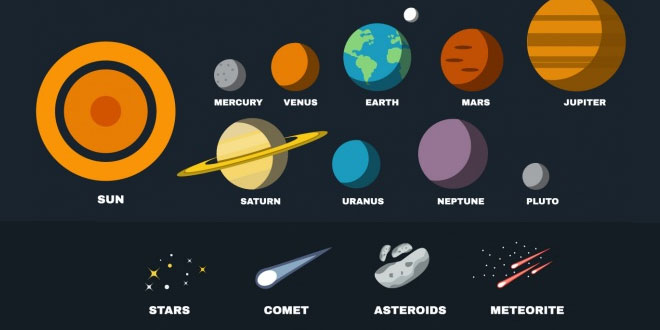Question: Briefly define ‘Universe’ and ‘Galaxy’?
Answer: The universe is the boundless expanse in which all matter, stars, planets, satellites etc exist. The most accepted Theory related to the birth of the universe is called Big Bang theory.
From this matter, many groups of stars were formed which we call galaxies. Our sun belongs to a galaxy called Milky Way (Akash Ganga in Hindi). The nearest galaxy to the Milky Way is Andromeda, which is 2 million light years away.
Question: What do you understand by ‘Solar System’.
Answer: The word ‘sol’ means the sun and ‘system’ refers to its family. The solar system is the name given to the sun and the group of heavenly bodies that revolve around it – the eight planets and their satellites or moons, meteors, comets and asteroids.
Question: Define the term Constellations?
Answer: Some stars together make a recognizable pattern in the sky which is called a constellation. Some prominent and easily recognizable constellations are the Great Bear-Ursa Major, Little Bear-Ursa Minor, Orion the Hunter and Scorpio the Scorpion.
Question: What according to you makes the planet Earth unique?
Answer: The earth is a unique planet in the solar system because of the following reasons –
- About 3/4th of the surface of the earth is covered with water and it supports life.
- The earth’s atmosphere has Oxygen which we breathe. It also helps to maintain a suitable range of temperature on the earth.
- All the other gases – Nitrogen, Carbon-dioxide and some other that are present in small amount in the atmosphere are critical for life on earth. For Eg.- Ozone in the atmosphere protects us from the harmful ultraviolet rays of the sun.
- The land has soil that supports plant life and other living beings.
Question: What is an Asteroid?
Answer: Pieces of rocks found orbiting the sun in a belt between Mars and Jupiter. These small rocky bodies are called asteroids. Most of these chunks of rock vary in size. Ceres is the largest asteroid which has a diameter of approximately 700 km.
 Class Notes NCERT Solutions for CBSE Students
Class Notes NCERT Solutions for CBSE Students




It helped me a lot!